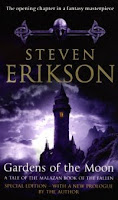
Once upon a time, there was a world...
How would you tell the story of Planet Earth? Is there a coherent story to tell?
Would you focus on the 150 million year reign of the dinosaurs, their rise and cataclysmic fall, or the roughly 10,000 year history of ‘civilized’ apes? Is it enough to depict the rise and fall of the Neanderthals – a "failed" branch of ‘humanity’ as broadly defined - who eventually lost to us Homo Sapiens? Should it be the tale of the triumph and attendant hubris of Humanity itself?
How would you tell the story of Planet Earth? Is there a coherent story to tell?
Would you focus on the 150 million year reign of the dinosaurs, their rise and cataclysmic fall, or the roughly 10,000 year history of ‘civilized’ apes? Is it enough to depict the rise and fall of the Neanderthals – a "failed" branch of ‘humanity’ as broadly defined - who eventually lost to us Homo Sapiens? Should it be the tale of the triumph and attendant hubris of Humanity itself?
Will you project the end of us self-acclaimed "intelligent overlords" of the Earth – the only species in existence to (arguably) subjugate its environment – and laugh and cry at the colossal, idiotic waste and ephemeral achievement?
Well... must you choose?
When you speak of a world entire, there is never one coherent Story, but rather many inter-linked ones, all equally important, poignant, funny, tragic, heroic, and possibly cathartic. You cannot reduce a tangled rope down to one thread and capture its essence, and a world will not reduce to one character, one viewpoint, one period of history, or one species. Many tales spring from a world because of what it is – a vast arena for actors and forces of unimaginable variety and complexity to interact. In some sense, the tale of any world is the world itself.
There is hope for an author however, and a story-telling approach presents itself: Instead of trying to tell all the stories (or "The Story") take a slice of history in media res and narrate it without bias or that ever-present fear of complexity. If you do, sometimes there will emerge a theme from the manageable if large tale you end up with; not an obvious or pleasing one necessarily, but a theme nonetheless… and illuminating at that!
Excuse this unabashed fan for saying that my favorite fantasy series achieves exactly this...
Introduction
As many readers will know "The Malazan Book of the Fallen" is a ten part series, written by Steven Erikson (SE) that I first started reading in May 2005. It is in my rather informed opinion, (forgive me the hubris) one of, if not the best high fantasy - or Science Fiction and Fantasy (SFF) series out there.
When I first read it, my fantasy obsession was in full bloom, although it was not yet the lifestyle it is today. I proudly claimed to have "evolved" in my reading, starting from Tolkein/ Clarke/ Asimov past Robert Jordan and Stephen King... and so on until I reached Stephen Donaldson. (Aside: a retrospective from back then on the old blog: My Fantasy Bibiliospective).
I thought I had read everything there was to read...
Despite my well documented proclivity to make stupid statements, that one was... really stupid, because with my discovery of "Gardens of the Moon", the opening volume of the series (from a hearty recommendation by Donaldson on his site), I was about to be blown away. Never before or since have I found anything that comes close in the genre for sheer scope of imagination, expert story-telling, or literary significance (yes, that old chestnut!).
The Books
 SE and ICE have imagined a world as vast, varied, and long-lived as the Earth itself (and perhaps longer inhabited by civilized/ intelligent life). Each then took a slice of this imagined history and narrated it, as part of what they call their ‘Dialogue’. It is a credit to their storytelling and world-building that these slices are vivid enough to convince the reader (well, me) of the existence of the parts they do not describe in any detail! As it stands, this dialogue started first with the authors and some friends role-playing/ gaming various characters they birthed, in the manner of the most hardcore of geeks, while out on remote archaeological digs. They eventually proceeded to writing (in their words) to/ for an audience of one – each other.
SE and ICE have imagined a world as vast, varied, and long-lived as the Earth itself (and perhaps longer inhabited by civilized/ intelligent life). Each then took a slice of this imagined history and narrated it, as part of what they call their ‘Dialogue’. It is a credit to their storytelling and world-building that these slices are vivid enough to convince the reader (well, me) of the existence of the parts they do not describe in any detail! As it stands, this dialogue started first with the authors and some friends role-playing/ gaming various characters they birthed, in the manner of the most hardcore of geeks, while out on remote archaeological digs. They eventually proceeded to writing (in their words) to/ for an audience of one – each other.Eriksons part of this dialogue is The Malazan Book of the Fallen; the ten books that are the focus of this ‘meditation’ and Esslemonts is a complementary and still emerging tale (reportedly a sextet) that has not quite revealed what 'theme' he is going for. This is similar to Erikson, whose theme and the major plot structure became apparent only in the final book or perhaps only in hindsight; but more on this later...
SE has also authored four short novellas featuring two side-characters that have a cameo in the main sequence, and has future plans to write two additional trilogies now that the main sequence is done - one a prequel describing events in the dim, mythic past of the world, and another that possibly carries some offshoots of the main story to their conclusion..
The main sequence books - each about 900 pages or so long - are:
1) Gardens of the Moon (first published 1999)
2) Deadhouse Gates (2000)
3) Memories of Ice (2001)
4) House of Chains (2002)
5) Midnight Tides (2004)
6) The Bonehunters (2006)
7) Reaper's Gale (2007)
8) Toll the Hounds (2008)
9) Dust of Dreams (2009)
10) The Crippled God (Feb 2011)
ICE’s thus far published works are:
1) Night of Knives (a prequel to the main series, 2005)
2) Return of the Crimson Guard ('offshoot to the series', 2008)
3) Stonewielder (another offshoot, Nov 2010)
4) Orb, Scepter, Throne (completed, awaiting publication)
My ‘Great Re-Read’
 Since the tenth and final book in the main sequence was coming out in early 2011, and the third ICE novel was scheduled for release in November of this year, I thought July of last year would be a fine time to start a re-read the entire series in a go, "as it was meant to be read", and to have every fact, every character, every plot-point fresh in my mind as I looked forward to the conclusion of the tale.
Since the tenth and final book in the main sequence was coming out in early 2011, and the third ICE novel was scheduled for release in November of this year, I thought July of last year would be a fine time to start a re-read the entire series in a go, "as it was meant to be read", and to have every fact, every character, every plot-point fresh in my mind as I looked forward to the conclusion of the tale.The plan was to use this here blog to record my reactions in this re-read - one book at a time. I was already about a third of the way into reading the second book, so I wrote up an introductory post... and promised a ‘reaction’ to the first book "Gardens of the Moon" would follow in short order.
It never did.
I finished my re-read about five months ago, after I got my hands on the final book in March, but still the posts did not come. Life intervened, and the series itself is not easily given to reflection - only reaction - in pieces. I had long since kissed objectivity goodbye, and did not want to end up writing just another set of book by book fan-boy reviews.
What follows then, in long form, is a meditation on the series for those interested...
Having taken on the near-impossible task of summing up the series without giving away too many spoilers, I propose to treat the rest of this essay as a list of my other key “ponderings” and “literary features” that stood out to me as I read. I’ve thought up a structure to this as follows (and yes, all the writing thus far was in prologue!):
Part 1: Elements - Theme, Plot, World, Geography - a broad description of these elements
Part 2: Quirks and Features - on what makes the series special/ gives it its ‘personality’
Part 3: Species - their role/ agency in-story and in the series as metaphors/ motifs
Part 4: Characters - a dissection of my favorites, and notes on why they are so
Part 5: Coda
I also apologize in advance for the excessive length of whatever-this-essay-pretends-to-be! I am unclear just who would be the audience for this, but as an exercise in literary analysis and critique, it is precious to me regardless.
I also apologize in advance for the excessive length of whatever-this-essay-pretends-to-be! I am unclear just who would be the audience for this, but as an exercise in literary analysis and critique, it is precious to me regardless.
The first two parts of this three parter (well, first three of four parts if you count the prologue) are already written, so this time I feel fairly confident that I will be able to complete the task I set myself! I might tack on another part (perhaps) and maybe write a coda as well - but that is not yet certain.
No comments:
Post a Comment